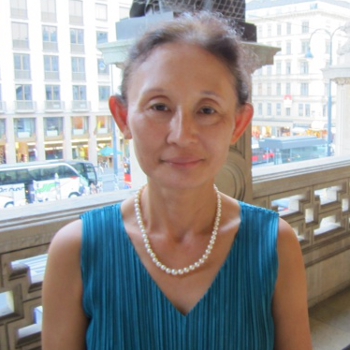The production of Donizetti’s masterpiece Lucia di Lammermoor by Mary Zimmerman returned to the Met with a solid male cast supporting Albina Shagimuratova, making her role debut at the house. The success on the opening night is largely due to the great ensemble work by the principal singers, chorus and orchestra; together they brought out the drama and beauty of the music, allowing the audience to savor a genuinely satisfying night at the opera.
Zimmerman moves the setting of the opera, based on a novel by Walter Scott on events in early 18th century, to the 19th century. The production is relatively simple, and save for a few unnecessary details such as a photographer at Lucia’s wedding and a doctor at the end of Lucia’s mad scene, efficiently tells the tragic tale of a young woman torn by the political conflict between her brother and her lover. The opera begins and ends in an outdoor setting, first in the woods where Lucia meets her lover Edgardo secretly, and the burial grounds of Edgardo’s family where he ends his life. The open outdoor settings represent genuine human feelings of love and death, while the closed political world of family feud and intrigue largely takes place inside the Lammermoor Castle.
Donizetti composed the music of Acts I and III representing human love with more lyricism and tenderness, while the music of the middle act is filled with tension and violent outbursts. The opera is almost sonata-like in structure, with Lucia’s mad scene in Act III an intriguing interlude. The overall musical structure of the opera as well as its subtleties and nuances was brilliantly realized by the Met Orchestra under a strong leadership of Maurizio Benini.
Maestro Benini began the overture with a deliberate but never plodding tempo, and, with appropriate pauses, gradually built the volume and complexity of the score. The brass section was especially fine with restrained but burnished sounds, as were the woodwinds. Mariko Anraku played the harp solo prelude to Lucia’s opening aria with exquisite clarity and delicacy, and Stefan Ragnar Hoskuldsson accompanied Lucia’s mad scene with a haunting flute echo. The Met Chorus was in an excellent form, and their work was especially noteworthy in the dramatic ending of Act II.
An announcement was made shortly before the curtain that Joseph Calleja, the tenor singing Lucia’s lover Edgardo, was suffering from the effects of a cold. His performance in Act I, which culminates with the famous duet with Lucia, was somewhat effortful and he seemed to struggle with high notes. He rallied in subsequent acts, however, and showed that a singer with a solid technique, a genuinely beautiful and unique voice and musicality could perform with elegance and passion even under difficult circumstances. Mr Calleja’s voice, with a distinct vibrato, was at the same time warm, penetrating and expressive. Perhaps to save his voice for high notes, he employed soft singing more than usual, but that was also effective in creating dramatic effects. His two difficult arias at the end of the opera were handled carefully but with urgent sense of despair mixed with yearning for death.
Soprano Albina Shagimuratova’s voice is not particularly distinct but it is a sweet, round and penetrating voice, without shrillness. Her singing throughout was free of vibrato, on pitch and accurate, and she was astounding in the evenness of her voice across registers. She hit the high notes solidly with no scooping, and while her coloratura passages may not be as agile nor intricate as one might like, they were instead executed with delicate beauty. Her mad scene was a tour de force, and she essayed every tricky note and transition with seeming ease, without losing the melodic and lyrical continuity of the music. Her characterization, however, was somewhat bland; she portrayed Lucia as a placid and passive character at the mercy of the men around her and their intrigues. Ms Shagimuratova’s Lucia did not show much development throughout the opera, and her descent into madness on her wedding night did not seem inevitable as it was somewhat difficult to develop sympathy for this character.
The dramatic core of the performance was provided by Luca Salsi in the role of Lucia’s brother, Enrico. He was able to wield his deep and big baritone to create a brutish, but not an unsympathetic, character who was desperate to restore the family fortune. This character was truly conflicted about sacrificing his sister to garner political alliance, and his guilt at the sight of her madness was heartfelt. Mr Salsi was the anchor of the musically and emotionally complex Act II, and the confrontation scene of Edgardo and Enrico at the beginning of Act III, with the two tall and solidly built singers circling each other to voice their mutual grievances, was one of the highlights of the evening.
While Alastair Miles sang and acted the part of Raimondo, the family minister and advisor, with appropriate elegance and sympathy, his voice lacked the necessary gravitas for the role. The tenor Matthew Plenk made a strong impression in his brief appearance as Arturo, Lucia’s fiancé and murder victim.
At the end of the evening, it was the two male singers who created complete characters with their voice and acting, while the soprano sang with great beauty and technique but failed to convince as an innocent girl unhinged. The conductor, chorus and orchestra contributed notably. Perhaps subsequent performances will see the soprano's characterization deepen and the tenor recover from his cold.




